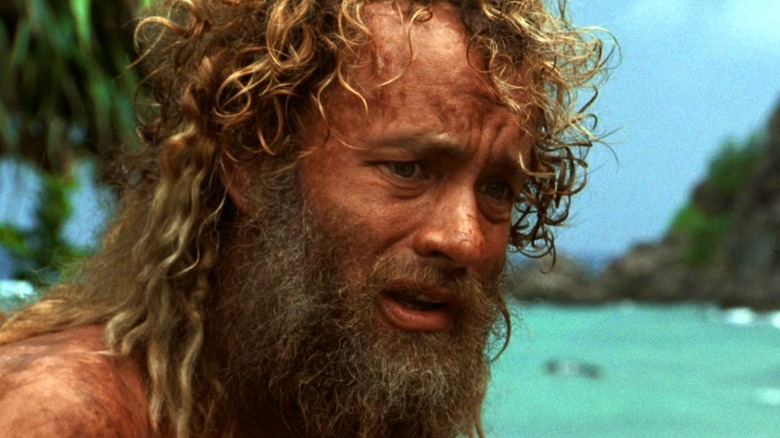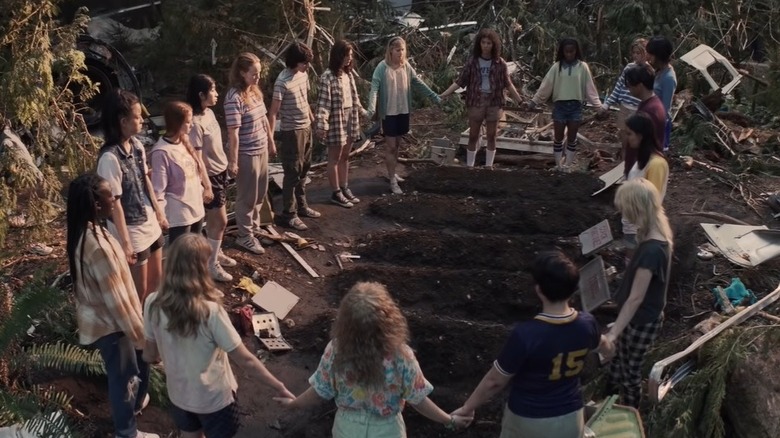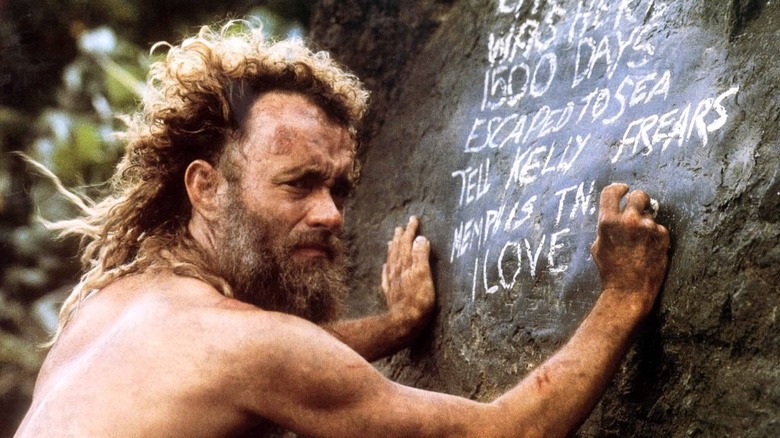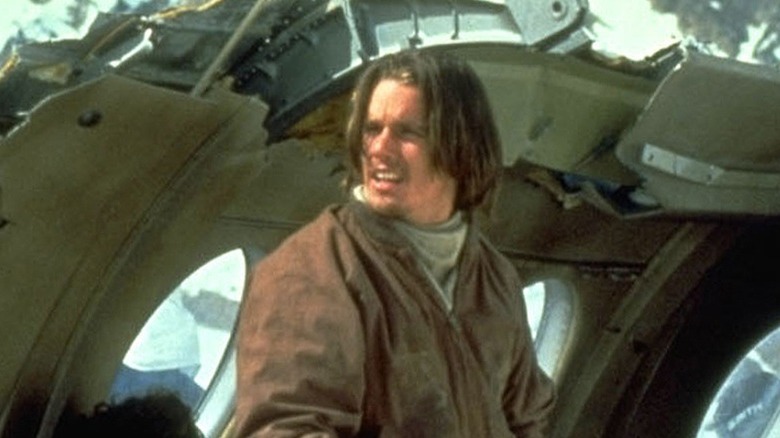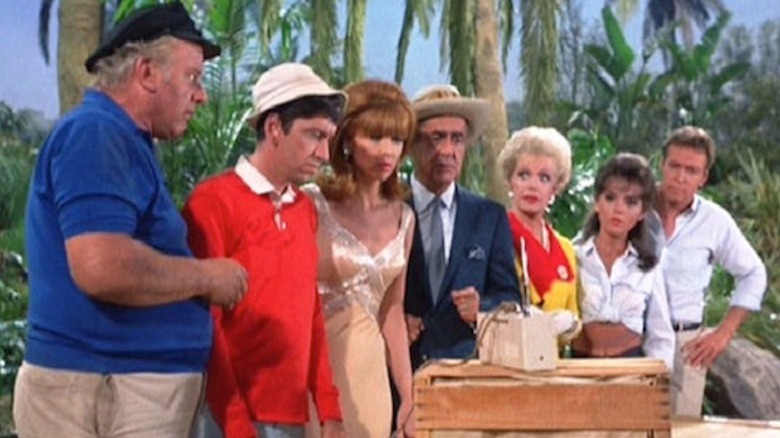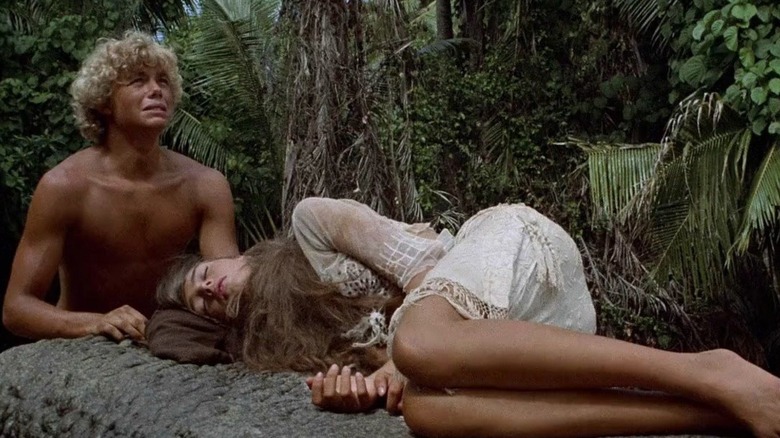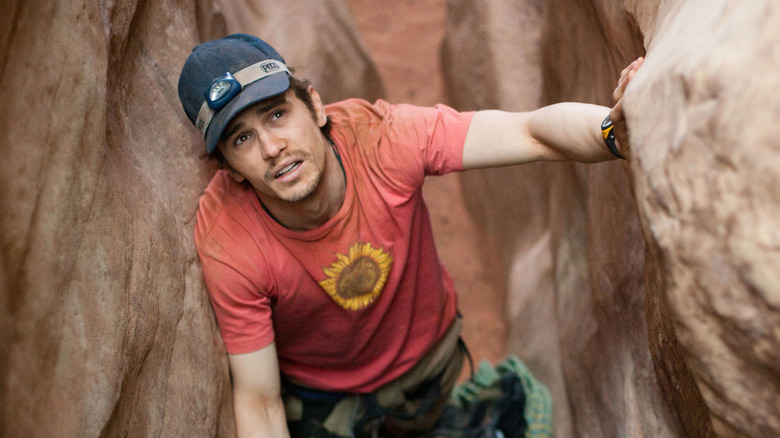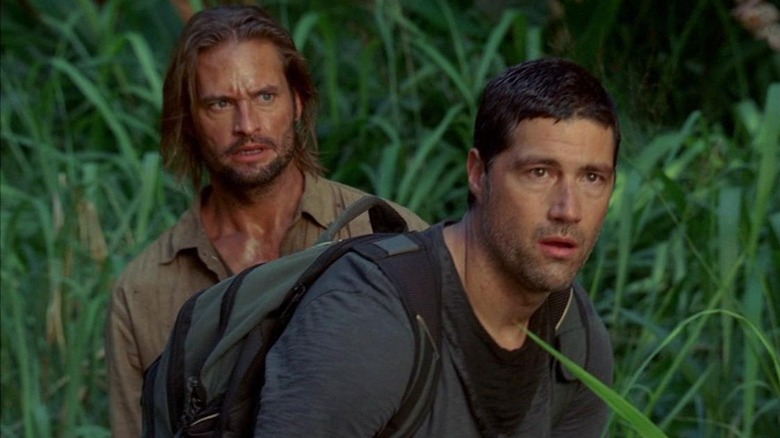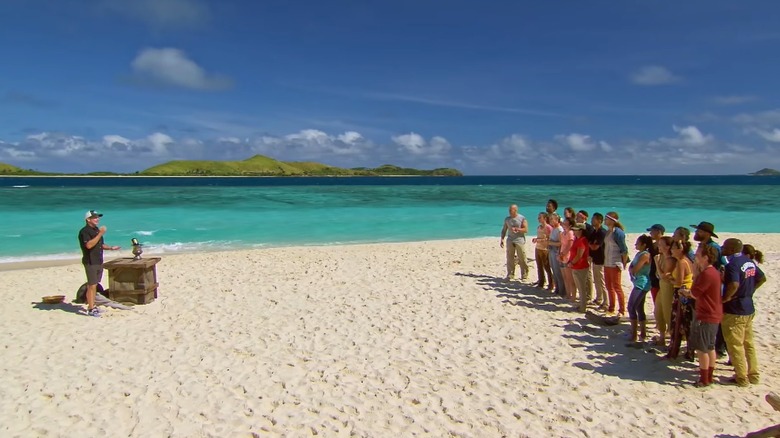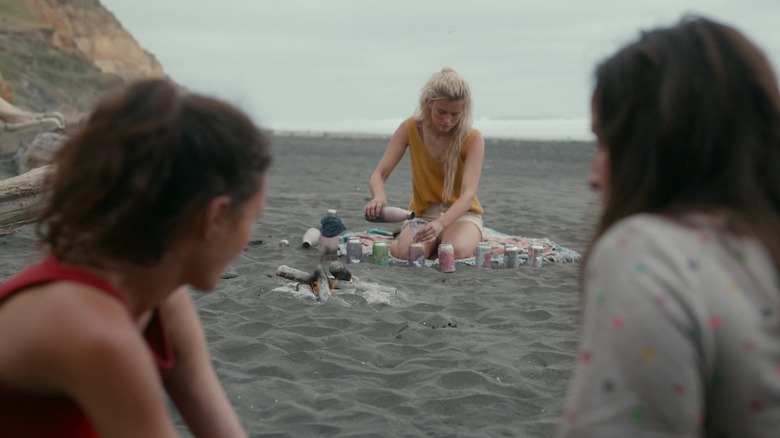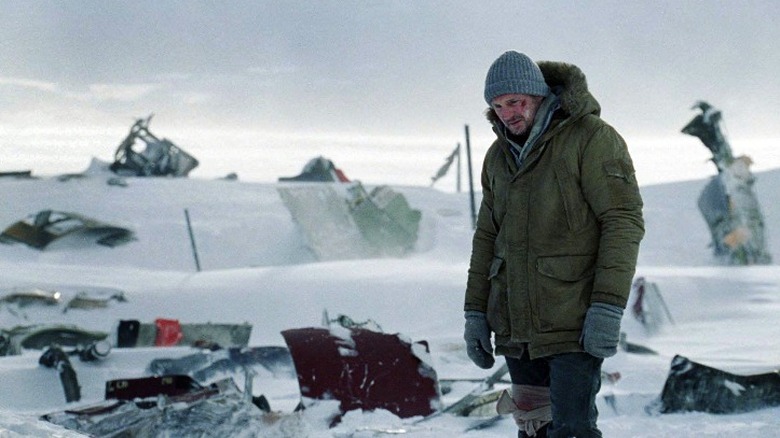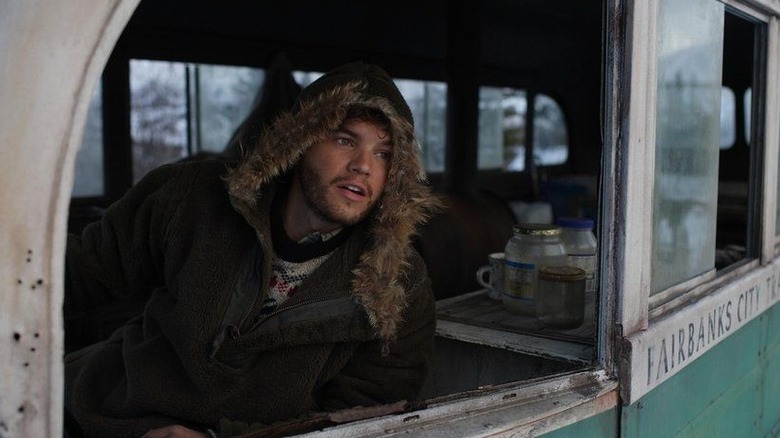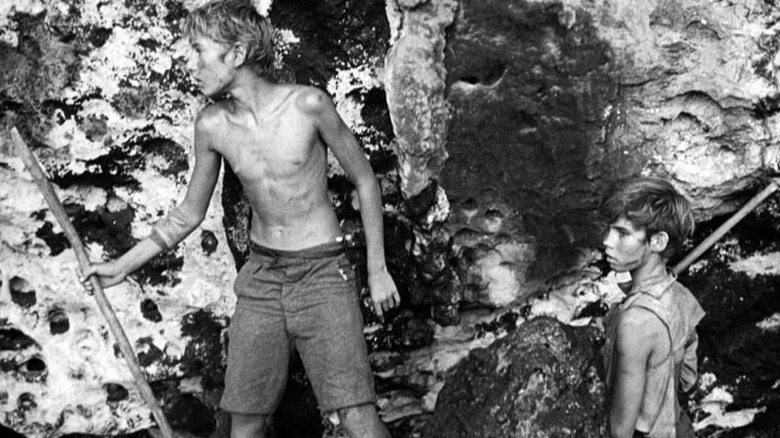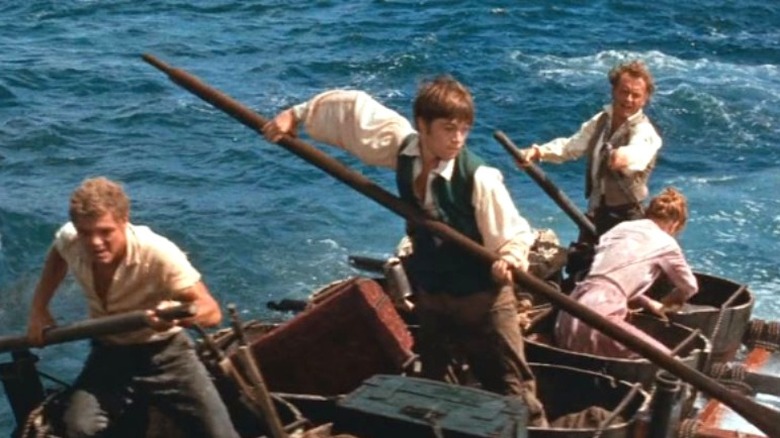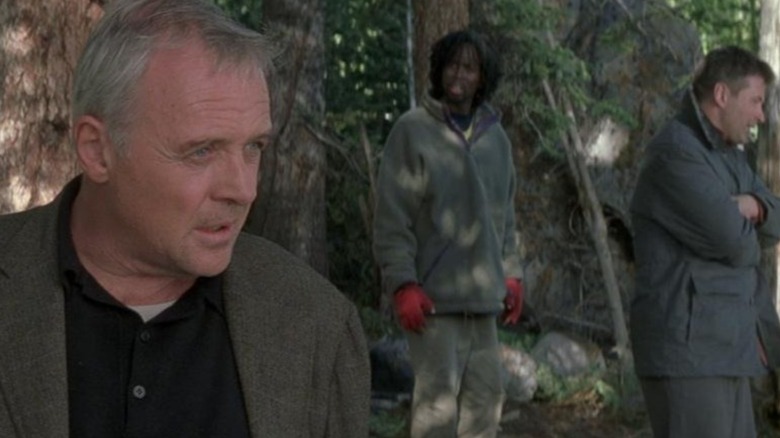Best Movies And TV Shows About People Surviving In The Wilderness
Showtime's buzzy series "Yellowjackets" is the latest in a long line of movies and TV shows focused upon humans surviving in the wilderness. Whether on a tropic island, the middle of the forest, the desert, or even the Arctic tundra, these screen experiences have long been a staple of film and TV, with the 1939 film "Five Came Back" serving as one of the earliest examples of the survival genre. Some are more gruesome than others (hello, "Yellowjackets"), but all of them emphasize the locale as an integral part of the survival story.
Merriam-Webster defines wilderness as "a tract or region uncultivated and uninhabited by human beings" and "an area essentially undisturbed by human activity together with its naturally developed life community." Therefore, we focused on not just survival films and TV shows, but ones that specifically highlighted people living in an uninhabitable land. This eliminated media from related genres, such as people lost at sea, disaster films set in cities, apocalypse films, or anything else that did not fit our strict definition of "wilderness." We also left documentaries off our list, although we did opt to include an iconic reality television series.
Here is a list of fourteen screen journeys –- some harrowing, some comedic, some both -– about humans surviving in the wilderness.
Yellowjackets
The newest entry on our list, "Yellowjackets," is also one of the most shockingly graphic survival journeys we have seen on screen, especially when it comes to TV. The Showtime series began airing in November 2021 and was quickly renewed for Season 2. The series is about a high school soccer team that crashes in the middle of the forest while on their way to the national championships. The crash occurs in 1996, and these scenes are interspersed with scenes from the present, alongside the occasional flashback to other time periods, such as childhood memories.
The plane holds the entirety of the Yellowjackets soccer team, including the four main characters the show focuses on in the present-day – Shauna (Melanie Lynskey as an adult and Sophie Nélisse as a teen), Natalie (Juliette Lewis and Sophie Thatcher), Taissa (Tawny Cypress and Jasmin Savoy Brown), and Misty (Christina Ricci and Sammi Hanratty). The head coach and some of the team die during the crash, and we have yet to learn the fate of the majority of the other characters from the 1996 time period.
"Yellowjackets" does not sugarcoat the survival story, exploring both the lengths these women went through to survive -– including cannibalism –- as well as the lasting effects of trauma.
Cast Away
"Cast Away" is one of the most celebrated survival movies there is, pulling in nearly $430 million at the box office, per Box Office Mojo, and launching a volleyball with a face into the cultural landscape. The 2000 flick features Tom Hanks as Chuck Noland, a FedEx executive whose airplane crashes on a deserted island in the South Pacific. As the only survivor of the crash, Chuck survives using an inflatable life raft. Once on the island, he must navigate the uninhabited land by himself. "I made 'Cast Away' because I wanted to examine the concept of four years of hopelessness, in which you have none of the requirements for living — food, water, shelter, fire, and company," Hanks said during an actors' roundtable facilitated by The Hollywood Reporter back in 2017.
Chuck ends up stranded on the island for four years, during which time he bonds with a volleyball he names Wilson (it is a Wilson Sporting Goods product, after all) that has a face due to a bloody handprint and some creativity. Chuck eventually escapes the island on a makeshift raft and is rescued by a cargo ship, but his girlfriend, Kelly Frears (Helen Hunt), has long since moved on. Hanks was nominated for many awards for "Cast Away," including an Academy Award, a BAFTA, and a Screen Actors Guild Award. He won the Golden Globe for his performance.
Alive
"Alive" is another especially brutal survival journey, but unlike "Yellowjackets" and many others, this story is based in truth. The 1993 film is based upon the book "Alive: The Story of the Andes Survivors," written by Piers Paul Read, which documents a real-life Andes plane crash that occurred in 1972. Much media has been created about this crash -– Uruguayan Air Force Flight 571 –- but the movie "Alive" is the most notable retelling. The film received mixed reviews from critics, per Rotten Tomatoes, but we appreciate the way it tugs at the heartstrings.
"Alive" is the story of an Uruguayan rugby team's crash in the Andes mountains, in which some of the passengers are ejected from the plane, and the others are left to survive in the wilderness for months. In total, 29 people die while 16 survive, and one of the ways that they endure is by eating the flesh of their friends and relatives. Ethan Hawke starred as Nando Parrado, a survivor who lost his mother and sister in the tragedy. Ultimately, those who remain are rescued by helicopter after Nando and Roberto Canessa (Josh Hamilton) escape the mountains and bring help.
Gilligan's Island
When it comes to characters stranded on deserted lands, "Gilligan's Island" ranks high up on the list of iconic media. The popular television show may have only aired for three seasons lasting from 1964 to 1967, but its lasting legacy on pop culture cannot be denied. Three television films have been made to continue the "Gilligan's Island" brand, and there have also been animated shows, a video game, a musical, and a novel. In 2004, TBS even tried to make it into reality TV with "The Real Gilligan's Island."
"Gilligan's Island" is about a group of individuals who end up stranded on a deserted island in the Pacific Ocean after a typhoon shipwrecks them. Onboard the S.S. Minnow are two crew members -– the titular character Gilligan (Bob Denver), the dim, clumsy first mate, and the boat's captain, Jonas "The Skipper" Grumby (Alan Hale Jr.) –- and five passengers. The passenger famously included a millionaire, his wife, a movie star, a farm girl, and a professor.
Much has been written about which of the two young women –- Hollywood star Ginger Grant (Tina Louise) or innocent small-towner Mary Ann Summers (Dawn Wells) –- people prefer, but we like them both and find it impossible to imagine the sitcom without one or the other. "Gilligan's Island" was lighthearted and fun in a way that most of the media on our list is not, but it nonetheless incorporated survival in the wilderness into its often silly narrative.
The Blue Lagoon
"The Blue Lagoon" is a controversial choice, since Brooke Shields' performance was so panned in the film that she even received a Golden Raspberry Award, or Razzie, for worst actress. Still, the movie was one of the most talked-about films of 1980 and even received an Oscar nomination for cinematography, so clearly it has its merits. We chose the film not because it is good, but because of its enduring cult status. Many of the film's filming locations have been incorporated into a fancy Fiji resort. "I feel like I'm a part of that island's history, and that island's a huge part of my life. After I left that island, my whole life changed," star Christopher Atkins told People.
Shields and Atkins play cousins Richard and Emmeline Lestrange who, along with a galley cook named Paddy Button (Leo McKern), survive a devastating shipwreck, though Paddy later dies. While Richard's father Arthur (William Daniels) eventually rescues them, the cousins are stranded on the island for years, and much of the film explores how they utilize the jungle and lagoon to build a meaningful life.
As they mature, Richard and Emmeline are left to navigate puberty and sexuality without any adult supervision, which leads to them developing a romantic and sexual relationship, which results in a child they name Paddy. The movie is based upon a 1908 novel of the same name, and it spawned a far less successful sequel in 1991, entitled "Return to the Blue Lagoon."
127 Hours
Unlike a lot of the other films and TV shows on this list, "127 Hours" does not involve any sort of devastating plane or boat crash. It is a survival film about a man, Aron Ralston (James Franco), who endures a terrifying hiking mishap that results in him being trapped in the wilderness for –- you guessed it –- 127 hours. The movie is based upon Ralston's book, "Between a Rock and a Hard Place," and it follows actual events that occurred in 2003 when he went out to hike in Canyonlands National Park without telling anyone of his plan.
The accident happens while Ralston is mountain climbing in Bluejohn Canyon, a slot canyon in the park, and a boulder falls on his right arm, trapping him. He must then ration his minimal amounts of food and water and, when that runs out, drink his own urine. Ralston logs his experience using a camcorder and eventually begins to hallucinate. The film's climax comes when Ralston successfully breaks and amputates his own arm, which then allows him to rappel down and find help. The film earned six Academy Award nominations, including best picture and best actor for Franco.
Lost
The ABC series "Lost" –- which has been called one of the best shows of all time by Time and Rolling Stone, and a new classic by Entertainment Weekly –- became a true cultural phenomenon when it made its debut in 2004. The sci-fi drama lasted for six seasons, accumulating many awards, including a Primetime Emmy for outstanding drama series in 2005 and the best dramatic television series at the 2006 Golden Globes.
The characters on "Lost" are all survivors of a tragic plane crash after Oceanic Flight 815 goes down. The large ensemble cast consisted of 14 regulars – including surgeon Jack Shephard (Matthew Fox), fugitive Kate Austen (Evangeline Lilly), and con man James Ford (Josh Holloway) alongside a plethora of supporting players. The show explores both the present-day crash survivors' experiences and their previous lives through flashbacks. There are elements of "Lost," from a smoke monster to the mysterious people known as "The Others," that still puzzle people to this day.
Survivor
We could not have a list of media about surviving the wilderness and not include the classic reality TV series "Survivor," which has aired more than 40 seasons. The iconic CBS show has been on the air since May 2000, and though many elements of the game have changed, it has remained wildly entertaining and incredibly popular. Seasons have been filmed in a multitude of locations across multiple continents, but the show has permanently set up shop in Fiji since Season 33, per Entertainment Weekly. Through watching "Survivor," we have learned much about survival, but just as much about human interaction, competition, and determination.
Contemporary "Survivor" contestants have had to learn to live off the land, even more so than earlier contestants. According to a 2020 Men's Health article, contestants get only about a cup of rice per day – which is why we have seen people eat things like coconuts, fish, crabs, chickens, wild pigs, and even rats. In one recent season, contestants started with no food and limited camp supplies. In addition to being strategic, social, and athletic, a good "Survivor" player must also build shelter, spear fish, create fire, and more. Bamboo toothbrushes, saltwater baths, and ocean bathroom breaks are the norm on "Survivor," as contestants explained to The Ringer.
The Wilds
"The Wilds" is your typical survivalist story in that it is about a bunch of young girls stranded on an uninhabited island as the result of a plane crash. These girls — including rich cellist Fatin Jadmani (Sophia Ali), competitive diver Rachel Reid (Reign Edwards), closeted Christian beauty queen Shelby Goodkind (Mia Healey), and six others -– are on their way to an empowerment retreat in Hawaii when their plane goes down. These strangers must learn to survive on the island while at the same time getting to know each other.
The story differs from the norm, however, because the girls are unknowingly part of a social experiment. The plane crash has been orchestrated by the Dawn of Eve retreat's organizer, Gretchen Klein (Rachel Griffiths), and the eight teenage survivors (nine girls were on the plane) are none the wiser. Much like "Yellowjackets" and "Lost," "The Wilds" interjects scenes from other timelines to flesh out the survival story. In "The Wilds," we see the castaways in their lives before the crash, as well as their lives after their rescue, where they are shown being interviewed by two men who are supposedly FBI agents.
The Grey
Ever since 2008's "Taken," Liam Neeson's career has seen him in a ton of action and adventure flicks, including "Unknown," "Battleship," "Honest Thief," and many more. We are used to seeing Neeson take on human villains, but only one of these films saw Neeson going head-to-head with a bunch of Canadian grey wolves — the 2011 survival film "The Grey." In the movie, Neeson plays John Ottway, a suicidal sharpshooter who makes his living protecting oil drillers from wolves as they work in Alaska. Towards the start of the film, Ottway and colleagues are left to fend for themselves in the Alaskan wilderness when their plane back to Anchorage experiences turbulence and malfunctions.
Ottway quickly takes charge of the scene, moving survivors away from the crash site once wolves descend to feed on the dead (and still living) bodies. As the men attempt to make their way out of the wilderness to safety, they struggle with big wolves, big egos, and the frigid elements. "Expected man-versus-wild, man-versus-absent-God themes ring more true than usual here, though not at the expense of the promised scares: Plenty of chase scenes and gory encounters keep tension high," wrote the Hollywood Reporter's movie critic.
Into the Wild
"Into the Wild" is both a survivalist adventure film as well as a coming-of-age biopic, and it is an excellent movie with fantastic performances. The 2007 film, based upon a book of the same name, was written, directed, and produced by Sean Penn, though Penn does not star. At the center of the film is Emile Hirsch, who stars as Chris McCandless, aka Alexander Supertramp, a recent college graduate who leaves his life behind to go live in the wild. Using an abandoned bus as shelter, McCandless lives in isolation in the Alaskan wilderness.
Through flashbacks, we learn that McCandless's journey started after he learned some upsetting family news, which prompted him to donate all his money, chuck his IDs and credit cards, and set out on a cross-country road trip. When his car is lost in a flash flood, McCandless takes to hitchhiking but also travels by kayak and freight train. McCandless encounters several interesting individuals during these flashbacks, including retired widower Ron Franz (Hal Holbrook) and Tracy Tatro (Kristen Stewart), an underaged girl who develops feelings for him.
The movie also contains flash-forward scenes -– set four months after the abandoned bus seen at the start of the film –- wherein McCandless is seen struggling to live successfully in nature and coming to the realization that life is better lived with others. He attempts to leave the wilderness but cannot and eventually dies, leaving behind his diary for the world as a parting gift.
Lord of the Flies
Chances are that you have read "Lord of the Flies" at some point in your life, probably as part of some middle or high school English assignment you barely remember. William Golding's 1954 novel is no doubt a classic, but the 1963 film adaptation is also very good and remains better than the 1990 adaptation, which is less faithful to the original story. If you are not much of a reader, or even if you are, the movie is absolutely worth checking out. It is a wonderful commentary on the dark side of human nature and how anarchy can develop, even amongst children.
"Lord of the Flies" is about a group of young schoolboys evacuated from a warzone who have their plane shot down. They end up on a deserted island, where they soon learn that no adults have survived the crash. Using a conch shell, Ralph (James Aubrey) and Piggy (Hugh Edwards) gather the other surviving castaways from the jungle. The boys then appoint a chief, build a fire, make a shelter, and generally establish some sort of order. However, things devolve into violence and incivility, and the group splits off into two –- one without rules altogether. The boys are rescued in the end, but not all of them make it out alive.
Swiss Family Robinson
Like with "The Blue Lagoon" and "Lord of the Flies," there have been multiple film adaptations of the novel "The Swiss Family Robinson," published in 1812 and written by Johann David Wyss. Between the 1940 and 1960 "Swiss Family Robinson" films, our favorite is the 1960 version, a survivalist film with a clear Disney sensibilities. It has become a classic film that multiple generations have come to love. There is even a Swiss Family Treehouse attraction at Magic Kingdom and several other Disney theme parks.
"Swiss Family Robinson" revolves around a Swiss family, the Robinsons, whose ship grounds on a deserted island after being attacked by pirates, caught in a storm, and abandoned by the crew. Father (John Mills) and Mother (Dorothy McGuire) Robinson and their three children are left to fend for themselves in the wilderness, keeping the pirates at bay using a quarantine flag.
They build a treehouse for shelter to keep them safe from dangerous wildlife, like a wild tiger. They eventually find another survivor of a pirate attack -– a girl named Roberta (Janet Munro) -– and take her in to protect her from the pirates. When Roberta's grandfather comes to save the day, four out of the five Robinsons (and Roberta, who has fallen for oldest son Fritz) opt to stay on the island.
The Edge
If this list gives you anything, we hope that you notice just how many survivalist stories take place in Alaska, "The Edge" included. The 1997 film, which was written by famed playwright David Mamet, stars Anthony Hopkins as Charles Morse, a billionaire businessman who is up at a remote lodge in a small Alaskan village along with his model wife Mickey (Elle Macpherson), photographer Bob Green (Alec Baldwin), and Bob's assistant Stephen (Harold Perrineau). When the three men set out to track down a local hunter, their plane hits a flock of birds, and they end up crashing into the water. The pilot dies, and the men must survive the elements after swimming ashore.
The survivors are able to make fire and survive the night – and they even start hiking south with the help of Charles' compass –- but trouble soon arises. When Stephen accidentally stabs himself with a fishing spear, his blood attracts a bear that kills him and forces the other men to flee their campsite. The men somehow manage to brave the wintry elements, take on the bear (successfully killing it), and find shelter in an abandoned cabin. Most shocking of all, perhaps, is the struggle between Charles and Bob, as it becomes clear that Bob is having an affair with Mickey and plans to help her kill her wealthy hubby.
